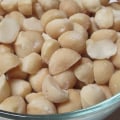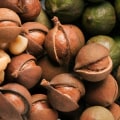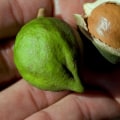A well-managed orchard with a distance between trees of 8 meters by 4 meters (or 312 trees per hectare) is expected to produce a maximum of 3.5 to 4 tons of nuts with shells per ha (12 to 13 kilograms per tree) at maturity, although poorly managed orchards or those in poor places may not reach these figures. There are three types of macadamia trees that produce edible nuts. These are Macadamia ternifolia, Macadamia integrifolia and Macadamia tetraphylla. The beautiful macadamia tree is the source of expensive but rich-tasting nuts, appreciated for their sweet and soft flesh.
These trees are only plants from warm regions, but it is possible to grow macadamia nuts in Southern California and other areas with tropical climates. If you're lucky enough to live in one of these tropical climates, knowing how to successfully grow macadamia trees can provide you with a lifetime supply of these desired nuts. Macadamia trees can start producing in 6 to 7 years, so it's important to devote a little time and effort to caring for the tree during the first phase of its life. Pruning should be done at the end of winter.
These trees are a long-term project because they don't bear fruit for years, but with careful care of macadamia plants, you might be lucky and have a plant that will bear fruit from seed in half a decade or so, and that would be something to brag about to your friends and neighbors. Macadamias are prolific producers, and each tree produces clusters of long, delicate, sweet-smelling white or pink flowers. . Like many tree crops, macadamias reproduce through grafting.
Therefore, commercial orchards usually contain thousands of trees, but only a few individuals, according to the study. This notable lack of genetic diversity means that macadamia crops are at greater risk of succumbing to diseases or changes in climate than trees with a more diverse population, according to a report published in The Guardian. By comparison, wild Australian macadamias have a rich diversity despite their narrow subtropical forest habitat, according to the study. The fruit of this majestic tree is a nut with a shell so hard that you need a hammer, a press or a special tool to break it.
As they are native to the northeastern region of New South Wales and southeastern Queensland, macadamias prefer frost-free environments where the temperature does not exceed 40°C. Most commercial trees are raised from rootstocks that increase plant health and resistance to pests and diseases, but you can try planting macadamia seeds for a chance to produce a tree. Macadamias are easily propagated from seed, but it can take 8 to 12 years for the tree to produce a crop. Tetraphylla, the macadamia with a rugged shell, a commercially cultivated crop that does not always have a rough shell and has sweet nuts.
In the 1860s, King Jacky, the elder Aboriginal member of the Logan River clan and the world's first “macadamia nut businessman”, was the first to market the nut to colonists. The fat content of macadamia nuts is higher than that of other popular nuts such as almonds, cashews and walnuts. A serving of macadamia nuts also contains dietary fiber, protein, manganese, thiamine, and a good amount of copper. Most macadamia varieties do not self-pollinate and cannot produce fruit without a nearby pollinator.
The faster you pick up the nuts from the ground, dry them and break them, the fresher they will be and taste better. Remove the outer shell, leave the shell and nut in place, and let them dry in a dry place away from sunlight for 2 to 3 weeks. Macadamia is a unique nut that ripens continuously during the fruiting season and requires multiple harvests. This means you'll need a place to dry the nuts slowly and steadily for a few days after picking them up from the ground (and removing the outer shells).
.




Leave Message